|
|
|
|
|
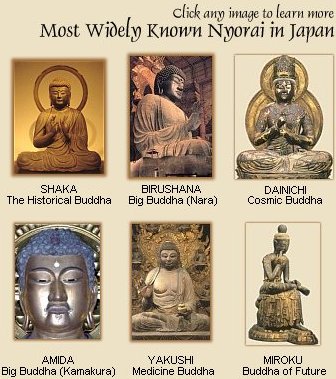
See below table. Less-known Buddha not listed.
|
|
 BUDDHA MENU BUDDHA MENU

Buddha (Sanskrit) • Fó 佛 (Chinese)
Tathagata (Skt.) • Rúlái 如来 (Chn.)
Nyorai 如来 (Japanese for Tathagata)
Butsu 仏 or Hotoke 仏 (Japanese)
Buddhahood = Awakened, Enlightened.
Ultimate state for Buddhist practitioners.
Origin = India
Buddha = Past participle of Sanskrit Buddh, “to awaken, to know.” Buddha is not a personal name, but a term of praise, like messiah. Tathagata is an honorific Sanskrit term for Buddha. Tathagata is rendered Rúlái 如来 in Chinese and Nyorai 如来 in Japanese. For all practical purposes, the terms Buddha, Tathagata, Rúlái, and Nyorai are synonymous in modern English usage. The Japanese also refer to Buddha as Butsu or Hotoke.
|
THE BUDDHA are those who have attained enlightenment, the ultimate state. In Theravada Buddhism, the monastic life is considered the sole path to spiritual perfection. Enlightenment is not thought possible for those living the secular life. But the Mahayana and Vajrayana schools of Buddhism claim that anyone, including laity, can attain enlightenment. The Mahayana and Vajrayana traditions include myriad Buddha, with the Historical Buddha (undisputed founder of Buddhism) considered just one among many. Theravada practitioners revere the Historical Buddha, but do not pay homage to the numerous other deities. For more details on this difference, please see Comparing Mahayana & Theravada Saviors.
|
|
English
|
Japanese
|
Sanskrit
|
Description
|
|
Shaka
Shìjiā (China)
Sākiya (Pali)
|
釈迦如来
|
Gautama or
Siddhartha or
Śākyamuni
|
Historical Buddha; lived in India near Nepal approximately 561 to 483 BC; the founder of Buddhism.
|
|
Amida
|
阿弥陀如来
|
Amitabha
|
Literally “Infinite Light / Life;” one of Japan’s loftiest savior figures, especially with Jōdo Sect; was Hōzō Bosatsu in earlier life; two attendants Kannon and Seishi; one of the Five Buddha of Wisdom (Five Tathagatas); West; one of the four satellite deities guarding Dainichi in the Ryōkai Mandala
|
|
Yakushi
|
薬師如来
|
Bhaisaya
Bhaisajya
Bhaishajya
|
Literally “medicine teacher;” Buddha of Medicine; two bodhisattva attendants, Nikko & Gekko; commands 12 Yaksa
|
|
Dainichi
|
大日如来
|
Vairocana
or
Mahavairocana Tathagata
|
Cosmic Buddha, Great Buddha, All-Encompassing Buddha; identified with Birushana Nyorai; messengers are the Myō-ō; very important to Shingon and Tendai sects of Esoteric Buddhism, especially the Shingon school; central deity among the Five Buddha of Wisdom (Five Tathagata); represents center or zenith; central deity on Japanese mandara (mandala) of Shingon and Tendai sects
|
|
Birushana or
Rushana
|
毘盧舍那佛
昆盧遮那仏
盧舎那仏
盧遮那仏
|
Vairocana
|
Big Buddha at Tōdaiji Temple in Nara; known as Dainichi in Esoteric Buddhism.
|
|
Miroku
|
弥勒菩薩
|
Maitreya
Also appears
as Bosatsu
|
Buddha of Future; very important to Shingon sect of Esoteric Buddhism; appears as Bosatsu in present age.
|
|
Jump to Top of Page
|
|
OTHER
NYORAI
|
Ashuku
阿閦
|
阿閦鞞
Ashukuhi
阿閦婆 Ashukuba
|
Akshobhya Tathagata. Mirror-like wisdom; one of the Five Buddha of Wisdom (Five Tathagatas); one of the four satellite deities guarding Dainichi Nyorai in the Ryōkai Mandala; Lord of Eastern Paradise called Abhirati (Sanskrit); English = Land of Exceeding Great Delight
|
|
Fukūjōju
不空成就
|
Amoghasiddha
|
Wisdom that all karma requires for its completion; one of the Five Buddha of Wisdom (Five Tathagatas); one of the four satellite deities guarding Dainichi Nyorai in the Ryōkai Mandala; North
|
|
Hōshō
宝生
also read
Hōjō 宝生
|
Ratnasam-bhava
|
Wisdom of distinction, wisdom of essential similarity; one of the Five Buddha of Wisdom (Five Tathagatas); one of the four satellite deities guarding Dainichi Nyorai in the Ryōkai Mandala; South
|
|
Sejizaiō Butsu
世自在王佛
|
Lokeshvararaja
Lokêśvararāja
|
One of the 53 Buddha of the past mentioned in the Sutra of Immerasurable Life 無量壽經卷. Helps believers to attain unhinderedness. A story in the sutra speaks of a king from bygone ages who had the opportunity to listen to a sermon given by Buddha Lokeshvararaja. Upon hearing the sermon, the king made up his mind to renounce his palace life, and he became a monk who later became Dharmakāra Bodhisattva (Hōzō Bosatsu 法藏菩薩), who then made 48 vows, fulfilled them, and became Amida Nyorai.
|
|
Godai
Nyorai
五大如来
Also
Gochi Nyorai
五智如来
|
Dhyāni Buddha
|
Godai Nyorai means “the Five Tathagata;” also called the Five Buddha of Wisdom.
|
|
Jump to Top of Page
|
|
Other
Groups
AND
Before the
Historical
Buddha
|
Sanzebutsu 三世仏
Buddhas of the Three Ages (Three Kalpa). Skt. = Kalpa means aeon, era, or cycle.
Sanze Jippō Shobutsu 三世十方諸仏
Buddhas of Three Ages & Ten Directions
According to Mahayana traditions, there are countless Buddhas who exist in countless world-systems, each with its own Buddha. In Japan, these Buddhas are collectively known as the Sanze Jippō Shobutsu 三世十方諸仏, which literally means "Buddhas of the Three Ages (past, present and future) and Ten Directions (four cardinal points, four intermediate directions, zenith and nadir). The three kalpa ages are the past (Jp. Shōgon 莊嚴), the present (Jp. Ken 賢), and the future (Jp. Shōshuku 星宿). There is also a much larger grouping called Sanze Sanzen Butsu 三世三千佛, which literally means "three thousand Buddhas from the three kalpas," or alternatively, the "thousand Buddhas in each of the three kalpas of the past, the present, and the future."
Kako Shichibutsu 過去七仏, Seven Buddhas of the Past
The current Buddhist era is called the "Auspicious Aeon" (Jp = Kengō 賢劫; Skt = Bhadra-kalpa). According to Buddhist lore, there are six Buddhas who came prior to Shaka (the Historical Buddha), three from the prior kalpa (Jp = Shōgon 莊嚴) and three in the current era (Kengō 賢劫). This group of seven is collectively known as the "Seven Buddhas of the Past." In Sanskrit, their names are:
- Vipasyin (past kalpa)
- Sikhin (past kalpa)
- Visvabhu (past kalpa)
- Krakucchanda (present cycle)
- Kanakamuni (present cycle)
- Kasyapa (Kassapa, Kashapa) (present cycle)
- Sakyamuni (present cycle; the Historical Buddha)
Shibutsu 四仏 - Four Buddha of Current Age
Shihō Shibutsu 四方四仏 - 4 Buddhas of 4 Directions
In Japanese, their names are:
|
|
Jump to Top of Page
|
|
OTHERS
Mandala Deities
|
The are many other Buddha who appear in Japanese mandalas, but they are not well-known nor the object of independent worship in Japan. See Mandala Deities for a large list of these Buddha, including the Bucchō (who personify the bump of knowledge atop the Buddha’s head), the Buddhas of Three Ages and Ten Directions, the Four Buddhas of the Four Directions, the Thirteen Buddhas invoked at the 13 memorial services held for the dead, and others.
|
|
Jump to Top of Page
|
|
Sanzonbutsu
三尊仏
|
Literally “Three Buddhist Deities” or “Triad.” Also written Sanzon 三尊 and Sanzonzō 三尊像. In Japanese Buddhist statuary history, the “triad” format was used soon after Buddhism’s arrival in Japan and standardized by the end of Japan’s Nara era (710-794 AD) based on Buddhist scriptures. The central deity is known as Chūson 中尊 (lit. central deity), while the two attendant deities, appearing on the left and right of the principal image, are called Kyōji 脇侍. Such triads are typically named after their central deity. Some of the most important triads are:
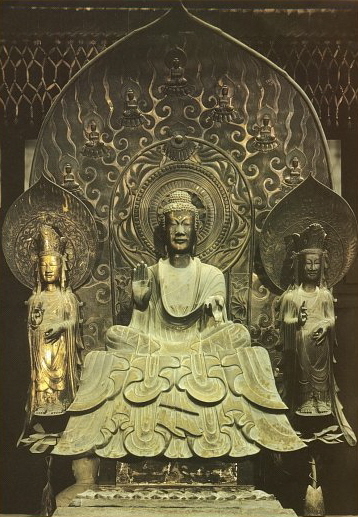
Famous bronze Shaka Trinity 釈迦三尊像, 632 AD
Shaka Height = 86.4 cm, Hōryūji Temple 法隆寺 in Nara
Surrounded by attendants Yaku-ō Bosatsu and Yakujō Bosatsu.
Early images of Buddha appear skinny and almost negroid.
Learn more about Buddhist statuary in 7th-century Japan.
|

There are two types of enlightened beings in Buddhist scriptures and iconography. In Japan, the two types are referred to as Nyorai (this page) and Bosatsu. Both types embody spiritual enlightenment and serve as guardians, teachers, and saviors to the faithful.
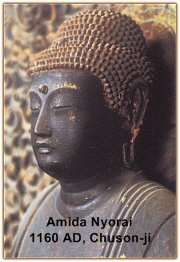 BUDDHA/ TATHAGATA / NYORAI BUDDHA/ TATHAGATA / NYORAI
The term “Buddha” -- past participle of Sanskrit buddh -- means to awaken or to know. Buddha is not a personal name, but a term of praise, like messiah or christ, the anointed one. Other terms besides Buddha are used to refer to fully enlighted beings. The ten honorary titles (ten epithets) of Buddha, for example, reflect the Mahayana idea that the Historical Buddha is just one among many Buddha. In Japan, the preferred title is Tathagata (Sanskrit), which is rendered as “Nyorai” in Japanese.
For all practical purposes, the words Buddha, Tathagata, and Nyorai are synonymous in modern English usage. Each is an honorific title given to those who have attained enlightenment. Gautama, the Historical Buddha, is among the most widely recognized Nyorai in Japan and mainland Asia.
BOSATSU / BODHISATTVA. The second type of enlightened being is the Bosatsu (Skt. Bodhisattva) or Rakan (Skt. Arhat). The Bosatsu are associated with Mahayana Buddhism (the type most practiced in Japan), while the Rakan come from Theravada traditions. One first becomes a Bodhisattva or Arhat before attaining Buddhahood. In Mahayana Buddhism, the Bosatsu is one who has reached the final stage of transmigration and awakening, just prior to becoming a Buddha. Those who become Bosatsu (or Arhat) will certainly achieve Buddhahood, but for a time, the Bosatsu renounce the blissful state of Nirvana (freedom from suffering), vowing to remain on earth in various guises (reincarnations) to help all living beings achieve salvation. Hōzō Bosatsu, for example, after countless good deeds over countless years, becomes Amida Buddba (Amida Nyorai). Please visit the Bosatsu Page for a listing of Japan’s most revered Bosatsu. In artwork, the Bosatsu are often depicted as attendants to the Nyorai (Buddha). Yet both types embody spiritual enlightenment and serve as guardians, teachers, and saviors to the faithful. To learn more about the differences between the Bosatsu (Bodhisattva) and Rakan (Arhat), please see Comparing Enlightened Beings in Theravada & Mahayana Buddhism.

32 Common Characteristics of Buddhist Deities (Sanjyūnisō 三十二相). The Nyorai are generally depicted with hair (round curls on their heads), elongated ears, a bump on top of their head, and a boss (third eye) in the forehead. Nyorai are all-hearing (the elongated ears), all-knowing (the bump of knowledge on top of head), and all-seeing (the third eye). Nyorai are sometimes shown with webbed fingers (Mammo-so in Japanese). The latter imagery represents “scooping up” people -- not letting them slip through the web -- and thus represents the desire to save as many people as possible. For a listing of the 32 major marks of a Buddha, and the 80 minor features, please click here.
|
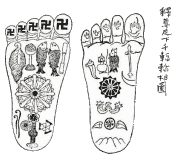
|
|
Image from the
Sho Eko Ho Kuan
(book used by Jodo Sect)
Courtesy sacred-texts.com
|
|
80 Minor Characteristics
Below Text Courtesy of: http://www.miho.or.jp
Over time, the Historical Buddha was portrayed with superhuman attributes, and the idea developed that he had certain physical features different from those of ordinary humans. Eventually 32 major signs (lakshanas) and 80 minor characteristics (vyanjanas) were described as distinguishing the physical form of the Buddha, though different texts (sutras) vary in the nature of these signs. Such signs, for example, include his soles being flat and marked with auspicious symbols <end excerpt>.
Specifically, statues of the Nyorai are nearly always depicted with one or more of the 32 physical marks associated with the actual appearance of the Historical Buddha (set forth in early Theravada scriptures). There are also 80 smaller characteristics. Among the 32 major marks, some of the most widely known are shown below (diagram also includes a few terms not related to the 32 markings):

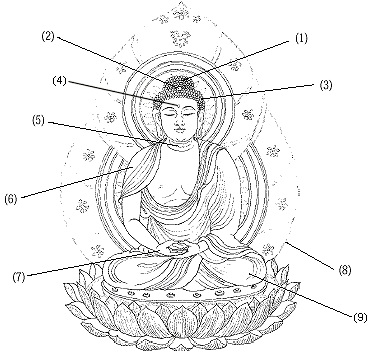
Diagram courtesy sotozen-net.or.jp
KEY TO ABOVE DIAGRAM:
- Nikkei 肉髻 in Japanese (Skt. = Ushinisha); the Bump of Knowledge; the uppermost bump of the head, which symbolizes spiritual wisdom; also said to represent accumulated wisdom, an elevated spiritual state. The Nikkei is often covered by spiral shaped curls of hair, like snail-shells, known as Rahotsu 螺髪. The Rahotsu symbolizes enlightenment, and first appeared in the 2nd century AD on Mathura Buddhas in North Central India <source JAANUS>. Another Japanese term for Nikkei jewel is Chōsei Nikkei 頂成肉髻.
- Nikkeishū 肉髻珠. The Nikkei Jewel, which radiates the light of wisdom, is located at the front base of the Nikkei. In Buddhist statuary, a small circle is typically carved here, or a circular crystal placed here. The Nikkeishu is sometimes painted red. In the Lotus Treasury World (Rengezōsekai 蓮華蔵世界), a pure land described in the Flower Garland Sutra and Brahma Net Sutra, an infinite number of Kebutsu 化仏 (lit. "transformed Buddha") emanate from the Nikkei jewel. The Kebutsu represent the infinite transformations (manifestations, forms, different bodies) in which the Buddhist deities appear to save sentient beings.
- Rahotsu 螺髪 (Japanese). Hair on head in small spiral curls; supposedly represents the stubble left on Prince Siddhartha’s head after he cut off his hair; according to one legend, he pulled his hair together into a top knot and chopped it off; it apparently went into fine curls (spiraling to the right), and never needed cutting again. Statues of the Amida Nyorai are said to contain 656 curls, a specific characteristic of that deity.
- Byakugo 白毫 in Japanese (Skt. = Urna). Lit. shining forehead hair, but more commonly translated as boss, or all-seeing third eye, in middle of forehead; symbolic third eye (spiritual eye), which appears on all statues of the Buddha (Nyorai); legend says the Historical Buddha had one strand of white hair (which curled to the right) in the center of his forehead, from which emitted rays of light to enlighten the world. In sculpture, the Byakugo is usually represented with a crystal or other valued gem. There are many stories. In one, the Historical Buddha has just entered into deep meditation after expounding the Muryogi-kyo (Sutra of Infinite Meaning) to a gathering of followers. At exactly that moment, flowers fell from heaven and other auspicious signs occurred; those present, gazing upon him, saw a ray of light spring forth from his forehead, illuminating the 18,000 worlds to the east. The Urna is a traditional marking still worn by Indian women today (gem set in middle of forehead); some traditions call it the sixth chakra (center of energy, wheel of light).
- Three creases in the neck. Not sure about this symbolism. Needs further research.
- Robe stitched together from rags, in manner prescribed for early monks.
- Mudra. There are five basic hand positions, each corresponding to five defining episodes in the life of the Historical Buddha (see Mudra page for details).
- Mandorla. Stylized representation of the magnificent light radiating from the Buddha. The word for halo in Japanese is Kōhai 光背 -- not sure if this is the light of wisdom or of compassion or of something else.
- Leg Positioning. Here we see the cross-legged meditation pose called the Lotus Position, one of three basic poses. Like the lotus, which grows out of the mud at the bottom of a pond, the Buddha is an enlightened being who "grew" out of the "mud" of the material world. Click here for a few more details on the lotus flower, or click here for a diagram of the three basic poses of most statues of the Buddha (Nyorai) and Bodhisattva (Bosatsu).

Early Japanese Buddhism. The earliest Buddha sculptures were brought over to Japan from Korea and China in the 6th and 7th centuries AD, or they were made by foreign artisans residing in Japan at the time. The style of these early Nyorai sculptures is often abstract - they often appear skinny or disproportional (not realistic). To some, this emphasizes their divinity and superhuman status. In the centuries that followed, however, the Japanese created their own style of realism, and today the statues carved by Japanese artisans in the Nara, Heian and Kamakura periods are perhaps the very “pinnacle” of Buddhist sculpture from the old world. See Asuka Era Art Tour and or Nara Era Art Tour.

Transmigration of Souls and Reincarnation. Unlike the teachings of Theravada Buddhism, the Mahayana teachings incorporate countless manifestations of Buddhas (this page) and Bodhisattvas. To Buddhists, the transmigration of souls from one creature to another has continued unabated for aeons. Those reaching full enlightenment are few, for the path to awakening is long and arduous. But the path is not closed, and in any period, one or more -- or none at all -- may appear. It is said that Gautama (Siddhartha, Shaka, the Historical Buddha) did not attain enlightenment in one life time, but rather struggled over many lives and through numerous incarnations to finally become a Bodhi-being. In some Buddhist traditions, the term Bodhisattva actually refers to Gautama Buddha prior to his enlightenment -- including the countless lives he passed through en route to Buddhahood. These earlier lives are called the Jatakas (birth stories), and they are a very frequent subject of Buddhist lore and art.

Six States of Existence (Transmigration, Reincarnation). All sentient beings are trapped in the cycle of suffering (Sanskrit = samsara), the cycle of death and rebirth, unless they can break free by achieving enlightenment. There are six states in the cycle. The lowest three states are called the three evil paths, or three bad states. They are (1) people in hells; (2) hungry ghosts; (3) animals. The highest three states are (4) Asuras; (5) Humans; (6) Devas. To escape from the cycle, one must either (1) achieve Buddhahood in one's life, or (2) be reborn in Amida Nyorai’s Western Pure Land, practice there, and achive enlightenment there. Those reborn in the Pure Land are no longer trapped in the cycle of birth and death (samsara), and can thus devote all their efforts to attaining enlightenment. For more details, please visit the Six States of Existence page. Technically speaking, the road from hell to Buddhahood covers ten stages, not six.

The Sacred Lotus (“hasu” in Japanese). Early on in Buddhist history, Shaka Nyorai (the Historical Buddha) is pictured seated on a lotus with four petals, representing the four great countries of Asia (India, China, Central Asia, and Iran) of the time. The lotus, moreover, is a symbol of purity. Although a beautiful flower, the lotus grows out of the mud at the bottom of a pond. The Buddha is an enlightened being who "grew" out of the "mud" of the material world. Like the lotus, the Buddha is beautiful and pure even though he existed in the material world. The “lotus” seat, moreover, is used very often in sculptures of the various Buddha (Nyorai) and Bosatsu (Bodhisattva), as is the lotus stem with flower, often shown held in the hands of the various deities.

Distinguishing Between Nyorai and Bosatsu Sculpture. There are some basic guidelines to help distinguish between the two types. Nyorai nearly always wear simple monk's robes, without jewelry or ornamentation. In contrast, sculptures of the Bosatsu are generally ornate. Often shown wearing jewelry and princely clothes, the Bosatsu can also be recognized (sometimes) by the objects they carry and the creatures they ride. There are many exceptions to the guidelines, mind you. Jizo Bosatsu, for example, is nearly always depicted wearing a simple monk's robe, while the historical Buddha (Shaka Nyorai) is sometimes shown with an ornate head piece, while images of Dainichi Nyorai are often wearing a crown and jewels. But don’t worry too much about rules that don’t always work. Despite inconsistencies, the guidelines can go far in enhancing your experience and understanding. The Nyorai can also be distinguished by their hand positions, or mudra. Even though this method doesn’t always work, it is still a sound strategy for identifying Buddhist artwork. For a review of the most common Mudra, please visit the Mudra (hand gestures) Page.

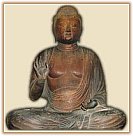 Five Buddha of Wisdom, Gochi Nyorai 五智如来 Five Buddha of Wisdom, Gochi Nyorai 五智如来
Especially important to the Shingon Sect of Esoteric Buddhsim, the Five Great Buddha of Wisdom (the Five Buddha of Meditation, the Five Jina, the Five Tathagatas, the Gochi Nyorai in Japanese) are eminations of the absolute Buddha. They appear frequently on the Japanese Ryōkai Mandala. They embody five fundamental wisdoms -- wisdom against anger, envy, desire, ignorance, and pride -- to help us break free from the cycle of death and rebirth (Skt. samsara). Each of the five Buddha has a specific mudra (hand gesture) that corresponds to five defining episodes in the life of the Historical Buddha (see Mudra page for details). Each of the five is also associated with a direction (north, south, east, west, center/zenith). The Bosatsu (Bodhisattva) often wear crowns that bear an effigy of their “spiritual father” -- i.e., one of the Five Buddha of Wisdom. The five are:
- Dainichi Nyorai (Skt. = Vairocana / Mahavairocana) | Center
- Fukūjōju Nyorai 不空成就 (Skt. = Amoghasiddhi) | North
- Hōshō Nyorai 宝生 (Skt. = Ratnasambhava) | South
- Ashuku Nyorai (Skt. = Akshobhya) | East
- Amida Nyorai (Skt. = Amitabha) | West
NOTE: In Japan, these Five Buddha (Jp. = Gobutsu 五仏) appear regularly in the Kongōkai Mandala (Diamond World Mandara, 金剛界曼荼, Skt. = Vajradhatu) and Taizōkai Mandala (Womb World or Matrix Mandara, 胎蔵曼荼羅, Skt. = Garbhadhatu). The Kongōkai Mandala represents the Cosmic Buddha (aka Dainichi Nyorai), and is associated with transcendental wisdom (static, crystal clear, and adamantine truth). The Taizōkai Mandala represents the world of physical phenomenon (physical manifestations of truth) and is associated with ultimate principles (Jp. = Ri, 理). Each of the Five Buddhas represents one of the Five Wisdoms (Jp. = Gochi 五智), hence their name (Five Buddha of Wisdom, Jp. = Gochi Nyorai, 五智如来).

Notes on Buddhist Iconography. Buddhist iconography and artwork first came to Japan via mainland Asia in the Asuka Period (approx. 538 - 710 AD), with the earliest sculptures mostly imported from Korea then China. In subsequent years, as the Japanese made their own sculptures, the resulting pieces looked almost identical to their Chinese and Korean counterparts. Buddha statues in those early years, for example, are extremely skinny. See Asuka Period Photo Tour and Nara Period Photo Tour. However, by the Kamakura era (1186 to 1316 AD), the Japanese were lending their own artistic and spiritual interpretation to Buddhist artwork, and a sense of realism takes hold. Sculptures of the Kamakura era are renown for their realism and lifelike proportions. Artists of that era also began using quartz crystals for the eyes, making the Buddha face appear almost alive. For the first time ever, Kamakura artists began carving various deities nude, such as Jizō and Benzaiten. Lifelike portrait paintings of founding masters and important monks, especially among the Zen sects, became popular as well during the Kamakura era.

|
Definitions of fundamental Buddhist concepts and terminology can be found on the Terminology page. For example, the terms Buddha, Tathagata, Nyorai, Butsu, and Hotoke are, for all practical purposes, synonymous in modern English usage. The terms enlightenment, nirvana, emancipation, and satori are likewise synonymous in modern English usage. These and other terms are discussed in detail on the Terminology page. For a guide to the basic teachings of the Historical Buddha, plus Japanese spellings for dozens of terms, please see Life & Teachings of the Historical Buddha.
|

 |
|
Nearly all statues of the Nyorai and Bosatsu come in three varieties -- standing, sitting, or half-leg pose, with the deity often shown atop a lotus-shaped platform. Less common types show the deity standing on a cloud, kneeling, or riding on an animal like the mythical Shishi (lions), the Peacock, or the Elephant.
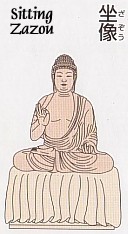 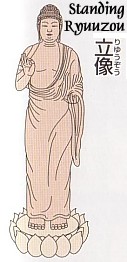 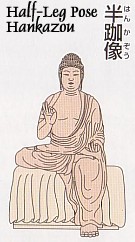
The seated/sitting style is known as the Lotus Position.
The half-leg form is called the Half Lotus Position
Above clipart courtesy of: “How to View Buddhist Statues (As if Wearing Glasses)”
Japanese Language Only, Published by Shogakukan, 2002, ISBN 4093435014
|

LEARN MORE
- Asuka Era Photo Tour and Nara Era Photo Tour.
View dozens of Bodhisattva stautes made in the 6th through 8th century.
- The Buddhist Icon and the Modern Gaze
by Bernard Faure, Professor, Stanford University, California
  Buddhist-Artwork.com, our sister site, launched in July 2006. This online store sells quality hand-carved wooden Buddha statues and Bodhisattva statues, especially those carved for the Japanese market. It is aimed at art lovers, Buddhist practitioners, and laity alike. Like this site (OnmarkProductions.com), it is not associated with any educational institution, private corporation, governmental agency, or religious group. Buddhist-Artwork.com, our sister site, launched in July 2006. This online store sells quality hand-carved wooden Buddha statues and Bodhisattva statues, especially those carved for the Japanese market. It is aimed at art lovers, Buddhist practitioners, and laity alike. Like this site (OnmarkProductions.com), it is not associated with any educational institution, private corporation, governmental agency, or religious group.
RESOURCES
MUSEUMS, PHOTO ARCHIVES

|
|